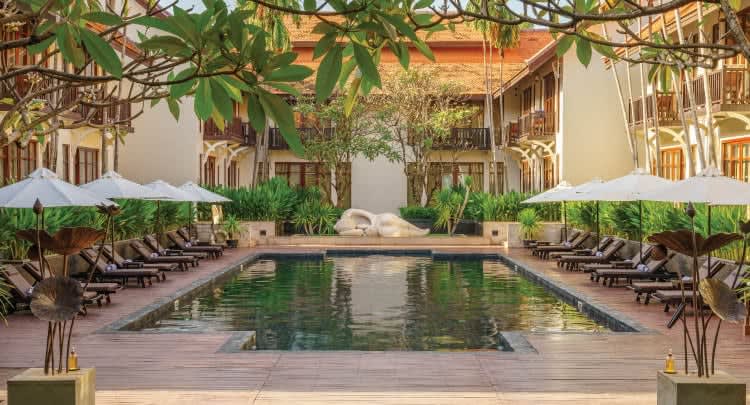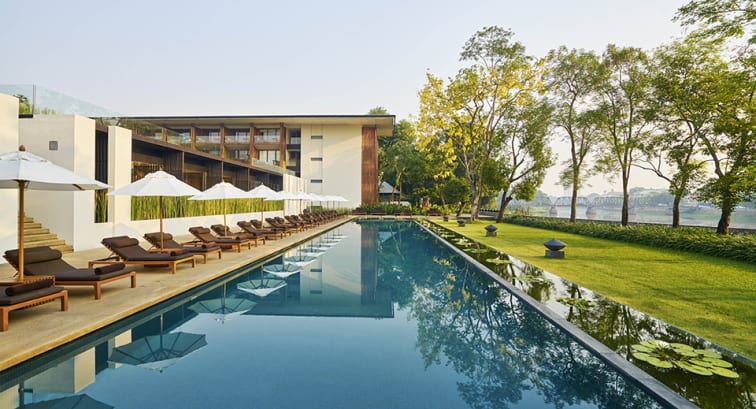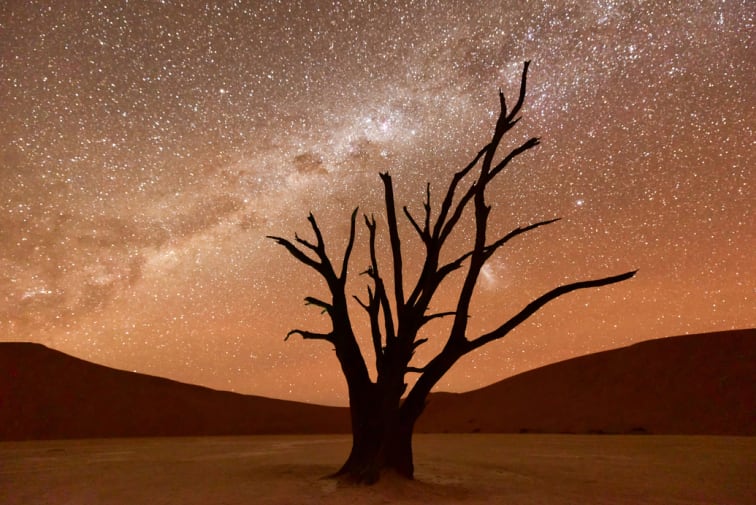The timeless art of slow travel through Indochina
Diverse and rich in culture, Indochina has long stood as a crossroads of trade, empire and revolution. Even today, the name evokes the complex legacy of French colonialism, echoes of which linger throughout the region. Dip a perfectly flaky croissant into your coffee on the quiet streets of Luang Prabang, or wander through the labyrinthine old quarters of Hanoi, where French legacy thrives amid fast-paced development.
Historically, travel through Indochina was characterised by its slow pace – whether navigating the languid currents of the Mekong River or crossing dense jungle – movement itself was an intrepid adventure. In southern Laos, an unfinished stretch of railway – now hidden under layers of vegetation – reveals the bold yet unrealised ambitions to expedite travel and trade.
Today, despite the high-speed trains available to crisscross the region, travel remains slow and deliberate by choice – a chance to truly immerse in the destination. Whether it's getting to know locals on Vietnam's backroads, a multi-day river cruise through the waterways of Laos, or exploring Cambodia's temples from the sky, slow travel fosters a profound connection to the culture and the environment. It's about embracing the journey itself, not just the destination.
Soaring over Angkor Wat, Cambodia

The ultimate in slow travel, hot-air balloons with their oversized wicker gondolas glide silently, carried by the winds. As the early morning sun casts shadows across dewy fields, the sacred mountain of Phnom Bok provides a dramatic backdrop. Float over Angkorian ruins such as Banteay Samré. Rising above the foliage, you are rewarded with a bird’s-eye view of the timeless Cambodian landscape – lush crops being tended, birds in flight, and water buffalo scattered between towering toddy palms.
Anantara Angkor Resort offers this aerial adventure either on its own or as part of their exclusive luxury package. This includes scenic countryside exploration by bicycle, quad, Vespa or vintage Jeep; trekking up Kulen Mountain, the birthplace of the Khmer Empire; kayaking through the floating villages of Tonlé Sap Lake; horseback riding in the wilderness for all levels; golfing at one of three world-class nearby courses; cooking classes featuring Anantara’s signature Spice Spoons experience; and rejuvenating Khmer massage therapies.
Old-world splendour, Vietnam
The coracle originated as a single-person, keel-less, flat-bottomed vessel in Wales – where it’s called “cwrwgl” – and in parts of Scotland and Ireland, where it’s known as a “currach”. As popular as they are lightweight (easy to carry on the back) and barely disturbing the water under a skilled hand, coracles are often used for fishing. Traditionally waterproofed with tar, variations of the coracle can be found in India, Tibet, Iran and Vietnam, where they’ve evolved to suit each river’s particular conditions.

The humble coracle, Vietnam’s iconic round boat that glides silently over the water, embodies a slower way of travel – an unhurried journey where the world unfolds at a natural pace.
On the Thu Bồn which meanders through Hoi An, enjoy a leisurely trip in your own coracle past ancient mangroves and a beguiling architectural mix of brightly painted French colonial, Chinese and Japanese-style buildings topped with aged roof tiles and timber balustrades. Retire afterwards to watch the sunset over the river at Anantara Hoi An Resort’s riverside restaurant, which serves modern dishes infused with Vietnamese flair in Viennese-inspired interiors.
Moving from water to land, rail remains one of the most iconic methods of slow travel, much like it was a century ago. In Vietnam, it was introduced in the 1880s, but it wasn’t until the late 1930s that the ambitious North-South Railway was completed. Back then, a journey from end-to-end took approximately two days and three nights.

Today, train travel remains a popular mode of transport, with The Vietage by Anantara offering luxurious journeys along the coast of central Vietnam, starting from Danang all the way south to Nha Trang. Its heritage-inspired interiors hark back to a golden age, with cuisine and drinks thoughtfully curated to match the region’s flavours. The Vietage offers journeys of all lengths, even connecting Anantara Hoi An Resort to Anantara Quy Nhon Villas in remote Quy Nhon Bay. Let an impeccably dressed porter handle your bags as you embark on a timeless rail journey, drifting past the changing landscapes of Vietnam.
Mellow Mekong, Laos

From its origins as frigid water dripping off Tibetan glaciers to its final leg in the steamy delta of southern Vietnam, the 4,350 km Mekong River has served as the lifeline of ancient civilisations all along its path through Southwest China, Myanmar, Laos, Thailand, Cambodia and Vietnam.
In the early mornings, when the sun has barely peeked over the palm-bristled horizon, a boat trip along Laos' stretch of the Mekong feels like gliding through a sepia-toned motion picture. Board the sleek, teakwood-trimmed Bohème, a new 50-metre luxury cruise from Mekong Kingdoms, with 13 cabins, including a royal suite offering 180° views of the Mekong. The countryside of northern Laos slides past in a succession of scenes seemingly unchanged through time, as you travel upstream or downstream between the capital, Vientiane, and Luang Prabang.

Drifting along the river, life unfolds as it has for centuries: buffalos bathe in the shallows; golden Buddhas peer down from their hillside perch; fishermen still cast their nets in the morning's orange glow, just as their ancestors have done for generations.
Whether you embark on an epic multi-night cruise or a day trip to the natural wonders of the Pak Ou Cave and Kuang Si Waterfall that dot Luang Prabang's jungled perimeter, the meandering Mekong forces you to slow down. Vignettes of humble village life and neon-green rice fields work like a rural tonic on hurried souls.
Back on land, Luang Prabang moves at a similarly honeyed pace. Here, days begin with saffron-robed monks collecting alms at dawn, then flow from bicycle rides around the surrounding countryside to long, lazy lunches at one of the French bistros perched along the riverbank. When the sun begins to dip behind the mountains, board the daybed-dotted Monsoon for sundowners and canapés on the river. Then explore the night market downtown before enjoying a dinner of spicy laab salads and curries.
Riverside romance in Bangkok, Thailand

In Bangkok, the Chao Phraya River tells its own stories of slow travel traditions. Loy Pela Voyages, a collection of meticulously restored rice barges, offers an unparalleled journey through time and culture with Anantara Riverside Bangkok Resort as its starting point. These elegant vessels, with their polished teakwood interiors and traditional Thai design elements, cruise gently past glittering temples, historic palaces and charming riverside communities.
The overnight journey takes guests from the bustling heart of Bangkok to the ancient capital of Ayutthaya, with stops at lesser-known temples and cultural sites along the way. As daylight fades, illuminated temples cast golden reflections on the water while guests retreat to luxurious staterooms. Onboard, guests enjoy exquisite Thai cuisine prepared by private chefs whilst the gentle lapping of water against the hull serves as a soothing soundtrack to this unhurried adventure.

The Mae Ping River offers one of Chiang Mai's most authentic slow travel experiences. At Anantara Chiang Mai, guests can explore this historic waterway aboard JAO Ping River Cruise, where traditional teak vessels glide at a pace that reveals cultural nuances often missed in rushed sightseeing. Morning journeys showcase riverside temples and vibrant communities, while evening cruises capture the magical transition as city lights begin to shimmer against darkening waters.
Adding to these river experiences is the latest Dibba Yana Chitta or 'Heavenly Boat', designed by acclaimed Thai National Artist Ajarn Chalermchai Kositpipat, who is renowned worldwide for his famous 'White Temple' in Chiang Rai. This highly exclusive vessel, featuring a hand-carved mythical figurehead that symbolises the journey between worlds, offers limited seats for guests to enjoy an extraordinary Thai fine dining experience.
Curated For You
You Might Also Like

Anantara Angkor Resort
Explore ancient Khmer legends and immerse yourself in the rich tapestry of history in this ancient kingdom at Anantara Angkor Resort. Wherever you find your inspiration, allow Anantara to guide your journey, with dedicated experience butlers on hand to facilitate your ultimate adventure. Explore legendary temples, delight in bespoke local experiences or relax and let your stresses and worries melt away with unlimited relaxation in our spa.
Anantara Hoi An Resort
Unwind in an elegant riverfront retreat on the central coast of Vietnam. Located a short walk from the UNESCO World Heritage Site of historic Hoi An, colonial style infused with local cultural elements inspires graceful resort surrounds. Bike along winding streets to the beautiful An Bang Beach. Learn traditional customs including cooking, painting and lantern-making. Cruise the river at sunset, taking in scenes of local fishermen casting their nets.
ANANTARA QUY NHON VILLAS
The East Sea coastline of Vietnam remains unexplored and lush. With now daily flights from Ho Chi Minh City, Hanoi and Hai Phong into the local airport, Anantara Quy Nhon Villas offers the perfect luxurious base from which to explore. Discover ancient Cham ruins rising up out the jungle. Set out on fishing adventures in one of the round coracle boats that famously dot the horizon. Return to your private villa for pool bliss and gourmet street eats served by your butler.
Anantara Riverside Bangkok Resort
Anantara Riverside boasts a unique setting, with tropical gardens overlooking the Chao Phraya providing a resort feel in the middle of vibrant Bangkok. Get out and explore all the city has to offer, then return to tranquil relaxation. Enjoy signature dining experiences, from sizzling teppanyaki and Pacific Rim cuisine, to a royal Thai feast on a restored rice barge.




